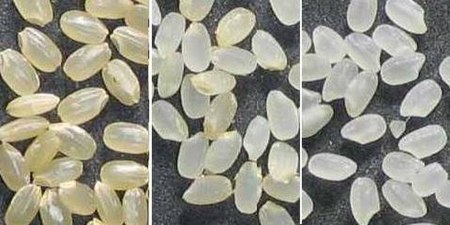Rice


Rice is a
Many varieties of rice have been bred to improve crop quality and productivity. Biotechnology has created Green Revolution rice able to produce high yields when supplied with nitrogen fertilizer and managed intensively. Other products are rice able to express human proteins for medicinal use; flood-tolerant or deepwater rice; and drought-tolerant and salt-tolerant varieties. Rice is used as a model organism in biology.
Dry rice grain is milled to remove the outer layers; depending on how much is removed, products range from brown rice to rice with germ and white rice. Some is
Production of rice is estimated to have caused over 1% of global greenhouse gas emissions in 2022. Rice yields are predicted to fall by some 20% with each 1°C rise in global mean temperature. In human culture, rice plays a role in certain religions and traditions, such as in weddings.
Description
The rice plant can grow to over 1 m (3 ft) tall; if in deep water, it can reach a length of 5 m (16 ft). A single plant may have several leafy stems or
Rice is a cereal belonging to the family
-
Detail of rice plant showing flowers grouped in panicle. Maleanthers protrude into the air where they can disperse their pollen.
Agronomy
Growing
Like all crops, rice depends for its growth on both biotic and abiotic environmental factors. The principal biotic factors are crop variety, pests, and plant diseases. Abiotic factors include the soil type, whether lowland or upland, amount of rain or irrigation water, temperature, day length, and intensity of sunlight.[5]
Rice grains can be planted directly into the field where they will grow, or seedlings can be grown in a seedbed and transplanted into the field. Direct seeding needs some 60 to 80 kg of grain per hectare, while transplanting needs less, around 40 kg per hectare, but requires far more labour.
-
Ploughing a rice terrace withwater buffaloes, Java
-
Farmers planting rice by hand in Cambodia
-
Mechanised rice planting in Japan
-
Ancient mountainside rice terraces at Banaue, Philippines
Harvesting
Across Asia, unmilled rice or "paddy" (Indonesian and Malay padi), was traditionally the product of
-
Rice combine harvester in Chiba Prefecture, Japan
-
After the harvest, rice straw is gathered in the traditional way from small paddy fields inMae Wang District, Thailand
-
Drying rice in Peravoor, India
Evolution
Phylogeny
The edible rice species are members of the
| Poaceae |
| |||||||||||||||||||||||||||||||||||||||||||||||||||
History

Cultivation, migration and trade spread rice around the world—first to much of east Asia, then further abroad, and eventually to the Americas as part of the Columbian exchange after 1492.[20] The now less common Oryza glaberrima (African rice) was independently domesticated in Africa around 3,000 years ago,[20] and introduced to the Americas by the Spanish.[21]
Commerce
| Rice production – 2021 | |
|---|---|
| Country | Millions of tonnes |
| 213 | |
| 195 | |
| 57 | |
| 54 | |
| 44 | |
| 30 | |
| World | 787[22] |
Production
In 2021, world production of rice was 787 million tonnes, led by China and India with a combined 52% of the total.[22] This placed rice fourth in the list of crops by production, after sugarcane, maize, and wheat.[23] Other major producers were Bangladesh, Indonesia and Vietnam.[23] 90% of world production is from Asia.[24]
-
Production of rice (2021)[23]
-
Rice's share (orange) of world crop production fell in the 21st century.
Yield records
The average world yield for rice was 4.7 metric tons per hectare (2.1 short tons per acre), in 2022.[25] Yuan Longping of China's National Hybrid Rice Research and Development Center set a world record for rice yield in 1999 at 17.1 metric tons per hectare (7.6 short tons per acre) on a demonstration plot. This employed specially developed hybrid rice and the System of Rice Intensification (SRI), an innovation in rice farming.[26]
Food security
Rice is a major food staple in Asia, Latin America, and some parts of Africa,[27] feeding over half the world's population.[24] However, a substantial part of the crop can be lost post-harvest through inefficient transportation, storage, and milling. A quarter of the crop in Nigeria is lost after harvest. Storage losses include damage by mould fungi if the rice is not dried sufficiently. In China, losses in modern metal silos were just 0.2%, compared to 7–13% when rice was stored by rural households.[28]
Processing
The dry grain is milled to remove the outer layers, namely the
-
Rice processing removes one or more layers to create marketable products.
A: Rice with chaff
B: Brown rice
C: Rice with germ
D: White rice with bran residue
E: Polished
(1): Chaff
(2): Bran
(3): Bran residue
(4): Cereal germ
(5): Endosperm
Trade
World trade figures are much smaller than those for production, as less than 8% of rice produced is traded internationally. China, an exporter of rice in the early 2000s, had become the world's largest importer of rice by 2013.[33] Developing countries are the main players in the world rice trade; by 2012, India was the largest exporter of rice, with Thailand and Vietnam the other largest exporters.[34]
Worldwide consumption
As of 2016, the countries that consumed the most rice were China (29% of total), India, and Indonesia.[35] By 2020, Bangladesh had taken third place from Indonesia. On an annual average from 2020-23, China consumed 154 million tonnes of rice, India consumed 109 million tonnes, and Bangladesh and Indonesia consumed about 36 million tonnes each. Across the world, rice consumption per capita fell in the 21st century as people in Asia and elsewhere ate less grain and more meat. An exception is Sub-Saharan Africa, where both per capita consumption of rice and population are increasing.[36]
Food
| Nutritional value per 100 g (3.5 oz) | |
|---|---|
| Energy | 544 kJ (130 kcal) |
28.6 g | |
0.2 g | |
2.4 g | |
Niacin (B3) | 3% 0.4 mg |
| Pantothenic acid (B5) | 8% 0.41 mg |
| Vitamin B6 | 3% 0.05 mg |
| Folate (B9) | 1% 2 μg |
| Minerals | Quantity %DV† |
| Calcium | 0% 3 mg |
| Iron | 1% 0.2 mg |
| Magnesium | 3% 13 mg |
| Manganese | 17% 0.38 mg |
| Phosphorus | 3% 37 mg |
| Potassium | 1% 29 mg |
| Sodium | 0% 0 mg |
| Zinc | 4% 0.4 mg |
| Other constituents | Quantity |
| Water | 69 g |
| †Percentages estimated using US recommendations for adults,[37] except for potassium, which is estimated based on expert recommendation from the National Academies.[38] | |
Eating qualities
Rice is a commonly-eaten food around the world. The
Nutrition
Cooked white rice is 69% water, 29%
Golden rice
Golden rice is a variety produced through
Rice and climate change
Greenhouse gases from rice

In 2022,
Effect of global warming on rice
A 2010 study found that, as a result of rising temperatures and decreasing solar radiation during the later years of the 20th century, the rice yield, measured at over 200 farms in seven Asian countries, decreased by between 10% and 20%. This may be caused by increased night-time respiration.[51][52] IRRI has predicted that Asian rice yields will fall by some 20% per 1°C rise in global mean temperature. Further, rice is unable to yield grain if the flowers experience a temperature of 35°C or more for over one hour, so the crop would be lost under these conditions.[53][54]
In the Po Valley in Italy, the arborio and carnaroli risotto rice varieties have suffered poor harvests through drought in the 21st century. The Ente Nazionale Risi is developing drought-resistant varieties; its nuovo prometeo variety has deep roots that enable it to tolerate drought, but is not suitable for risotto.[55]
Pests, weeds, and diseases
Pests and weeds
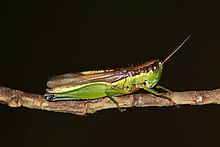
Rice yield can be reduced by weed growth, and a wide variety of pests including insects, nematodes, rodents such as rats, snails, and birds.
Diseases
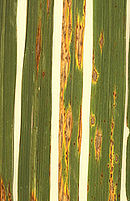
Rice blast, caused by the fungus Magnaporthe grisea, is the most serious disease of growing rice.[60] It and
Pest management

Farmers in China, Indonesia and the Philippines have traditionally managed weeds and pests by the polycultural practice of raising ducks and sometimes fish in their rice paddies. These produce valuable additional crops, eat small pest animals, manure the rice, and in the case of ducks also control weeds.[68][69]
Rice plants produce their own chemical defences to protect themselves from pest attacks. Some synthetic chemicals, such as the herbicide 2,4-D, cause the plant to increase the production of certain defensive chemicals and thereby increase the plant's resistance to some types of pests.[70] Conversely, other chemicals, such as the insecticide imidacloprid, appear to induce changes in the gene expression of the rice that make the plant more susceptible to certain pests.[71]
Plant breeders have created rice cultivars incorporating
Ecotypes and cultivars
The
The complete genome of rice was sequenced in 2005, making it the first crop plant to reach this status.[77] Since then, the genomes of hundreds of types of rice, both wild and cultivated, and including both Asian and African rice species, have been sequenced.[78]
Biotechnology
High-yielding varieties
The high-yielding varieties are a group of crops created during the Green Revolution to increase global food production radically. The first Green Revolution rice variety, IR8, was produced in 1966 at the International Rice Research Institute through a cross between an Indonesian variety named "Peta" and a Chinese variety named "Dee Geo Woo Gen".[79] Green Revolution varieties were bred to have short strong stems so that the rice would not lodge or fall over. This enabled them to stay upright and productive even with heavy applications of fertilizer.[79]
Expression of human proteins
Flood-tolerant rice

In areas subject to
Drought-tolerant rice
The
Salt-tolerant rice
Soil salinity poses a major threat to rice crop productivity, particularly along low-lying coastal areas during the dry season.[84][88] For example, roughly 1 million hectares (2.5 million acres) of the coastal areas of Bangladesh are affected by saline soils.[89] These high concentrations of salt can severely affect rice plants' physiology, especially during early stages of growth, and as such farmers are often forced to abandon these areas.[90]
Progress has been made in developing rice varieties capable of tolerating such conditions; the hybrid created from the cross between the commercial rice variety IR56 and the wild rice species Oryza coarctata is one example.[91] O. coarctata can grow in soils with double the limit of salinity of normal varieties, but does not produce edible rice.[91] Developed by the International Rice Research Institute, the hybrid variety utilises specialised leaf glands that remove salt into the atmosphere. It was produced from one successful embryo out of 34,000 crosses between the two species; this was then backcrossed to IR56 with the aim of preserving the genes responsible for salt tolerance that were inherited from O. coarctata.[90]
Environment-friendly rice
Producing rice in paddies is harmful for the environment due to the release of methane by methanogenic bacteria. These bacteria live in the anaerobic waterlogged soil, consuming nutrients released by rice roots. Putting the barley gene SUSIBA2 into rice creates a shift in biomass production from root to shoot, decreasing the methanogen population, and resulting in a reduction of methane emissions of up to 97%. Further, the modification increases the amount of rice grains.[92][93]
Model organism
Rice is used as a model organism for investigating the mechanisms of meiosis and DNA repair in higher plants.[94] For example, study using rice has shown that the gene OsRAD51C is necessary for the accurate repair of DNA double-strand breaks during meiosis.[95]
In human culture

Rice plays an important role in certain religions and popular beliefs. In Hindu wedding ceremonies, rice, denoting fertility, prosperity, and purity, is thrown into the sacred fire, a custom modified in Western weddings, where people throw rice.[96] In Malay weddings, rice features in multiple special wedding foods such as sweet glutinous rice.[97] In Japan and the Philippines, rice wine is used for weddings and other celebrations.[98] Dewi Sri is a goddess of the Indo-Malaysian archipelago, who in myth is transformed into rice or other crops.[99] The start of the rice planting season is marked in Asian countries including Nepal and Cambodia with a Royal Ploughing Ceremony.[100][101][102]
See also
References
- ^ "Oryza sativa L." Royal Botanic Gardens, Kew. Retrieved December 6, 2023.
- ^ "The Rice Plant". Rice Hub. Retrieved December 6, 2023.
- S2CID 256799161.
- ^ "The Rice Plant and How it Grows". International Rice Research Institute. Archived from the original on January 6, 2009.
- ISBN 978-1-84826-368-0.
- ^ "How to plant rice". International Rice Research Institute. Retrieved December 29, 2023.
- ^ "Transplanting". International Rice Research Institute. Retrieved December 29, 2023.
- ^ Uphoff, Norman. "More rice with less water through SRI - the System of Rice Intensification" (PDF). Cornell University. Archived from the original (PDF) on December 26, 2011. Retrieved May 13, 2012.
- ^ "Water Management". International Rice Research Institute. Retrieved November 4, 2023.
- ISBN 978-971-22-0005-2.
- ISBN 978-971-10-4172-4.
- ^ "Harvesting systems". International Rice Research Institute. Retrieved January 3, 2024.
- ^ "Harvesting". International Rice Research Institute. Retrieved December 6, 2023.
- ^ "Drying". International Rice Research Institute. Retrieved December 6, 2023.
- ISSN 1674-4918.
- ^ PMID 21536870.
- ^ from the original on September 24, 2020. Retrieved March 29, 2021.
- PMID 28087768.
- .
- ^ PMID 30845217.
- ISBN 978-0-309-04990-0. Archivedfrom the original on January 22, 2009. Retrieved July 18, 2008.
- ^ FAOSTAT, UN Food and Agriculture Organization, Corporate Statistical Database. 2023. Retrieved December 4, 2023.
- ^ S2CID 240163091. Retrieved December 10, 2021.
- ^ PMID 31619630.
- ^ "FAOSTAT: Production-Crops, 2022 data". United Nations Food and Agriculture Organization. 2022.
- ^ Yuan, Longping (2010). "A Scientist's Perspective on Experience with SRI in China for Raising the Yields of Super Hybrid Rice" (PDF). Cornell University. Archived from the original (PDF) on November 20, 2011.
- ^ "Food Staple". National Geographic Education. Retrieved December 6, 2023.
- PMID 28231087.
- ^ "Milling". International Rice Research Institute. Retrieved January 4, 2024.
- ^ a b c "Types of rice". Rice Association. Archived from the original on August 2, 2018. Retrieved August 2, 2018.
- PMID 24253052.
- ISSN 0378-4290.
- ^ Cendrowski, Scott (July 25, 2013). "The Rice Rush". Fortune. Retrieved January 4, 2024.
- ^ Chilkoti, A. (October 30, 2012). "India and the Price of Rice". Financial Times. London. Archived from the original on January 20, 2013.
- ^ "Global rice consumption continues to grow". Grain Central. March 26, 2018. Retrieved December 5, 2023.
- US Department of Agriculture. September 27, 2023. Retrieved December 5, 2023.
- ^ United States Food and Drug Administration (2024). "Daily Value on the Nutrition and Supplement Facts Labels". Retrieved March 28, 2024.
- )
- ^ "Types of rice". The Rice Association. Retrieved March 24, 2024.
- US Department of Agriculture. April 2018. Retrieved December 5, 2023.
- PMID 30307723. Retrieved December 5, 2023.
- ^ "Golden Rice Q&A". Golden Rice Project. Retrieved January 3, 2024.
- S2CID 40258379.
- ^ Lynas, Mark (August 26, 2013). "Anti-GMO Activists Lie About Attack on Rice Crop (and About So Many Other Things)". Slate Magazine. Retrieved August 21, 2021.
- .
- ^ "Sectors: Rice cultivation". climatetrace.org. Retrieved December 7, 2023.
- S2CID 263197017.
Rice paddies …. account for ~48% of greenhouse gas (GHG) emissions from croplands.
- S2CID 233403787.
- JSTOR 1311906. Archived from the originalon January 15, 2008. Retrieved February 4, 2008.
- S2CID 263197017.
- PMID 20696908.
- ^ Black, R. (August 9, 2010). "Rice yields falling under global warming". BBC News: Science & Environment. Archived from the original on April 5, 2018. Retrieved August 9, 2010.
- ^ Singh, S.K. (2016). "Climate Change: Impact on Indian Agriculture & its Mitigation". Journal of Basic and Applied Engineering Research. 3 (10): 857–859.
- ISBN 978-1-5225-1047-5.
- ^ Spaggiari, Ottavia (February 29, 2024). "Risotto crisis: the fight to save Italy's beloved dish from extinction". The Guardian.
- ^ "Pests and diseases management". International Rice Research Institute. Retrieved January 4, 2024.
- ^ "Insects". International Rice Research Institute. Retrieved January 4, 2024.
- S2CID 1941852.
- ISBN 978-971-22-0211-7. Archived from the original(PDF) on April 3, 2012.
- PMID 15846337.
- ^ PMID 24906128.
- PMID 15012543.
- ^ Jahn, Gary C.; Khiev. B.; Pol, C.; Chhorn, N.; Pheng, S.; Preap, V. (2001). "Developing sustainable pest management for rice in Cambodia". In Suthipradit S.; Kuntha C.; Lorlowhakarn, S.; Rakngan, J. (eds.). Sustainable Agriculture: Possibility and Direction. Bangkok (Thailand): National Science and Technology Development Agency. pp. 243–258.
- .
- ^ "Bangladeshi farmers banish insecticides". SCIDEV.net. July 30, 2004. Archived from the original on January 26, 2008. Retrieved May 13, 2012.
- S2CID 204702698.
- ^ Hamilton, Henry Sackville (January 18, 2008). "The pesticide paradox". International Rice Research Institute. Archived from the original on January 19, 2012.
- ^ Bezemer, Marjolein (October 23, 2022). "Mixed farming increases rice yield". reNature Foundation. Archived from the original on October 11, 2019. Retrieved January 2, 2024.
- ^ Cagauan, A. G.; Branckaert, R. D.; Van Hove, C. (2000). "Integrating fish and azolla into rice-duck farming in Asia" (PDF). Naga (ICLARM Quarterly). 23 (1): 4–10.
- PMID 22313362.
- PMID 22544984.
- S2CID 202011174.
- ^ "The International Rice Genebank – conserving rice". International Rice Research Institute. Archived from the original on October 23, 2012.
- S2CID 3360337.
- ISSN 2697-6056.
- ^ "NERICA: Rice for Life" (PDF). Africa Rice Center (WARDA). 2001. Archived from the original (PDF) on December 4, 2003. Retrieved July 7, 2008.
- ^ Gillis, J. (August 11, 2005). "Rice Genome Fully Mapped". The Washington Post. Archived from the original on March 30, 2017. Retrieved September 10, 2017.
- PMID 35821092.
- ^ a b Hettel, Gene (November 18, 2016). "IR8—a rice variety for the ages". Rice Today. Retrieved December 29, 2023.
- S2CID 84688423.
- S2CID 3106602.
- ^ S2CID 86192842.
- ^ ""Climate change-ready rice". International Rice Research Institute. Archived from the original on October 28, 2012. Retrieved October 31, 2013.
- ^ a b "Drought, submergence and salinity management". International Rice Research Institute (IRRI). Archived from the original on November 1, 2013. Retrieved September 29, 2013.
- ^ a b ""Climate change-ready rice". International Rice Research Institute (IRRI). Archived from the original on March 14, 2014. Retrieved September 29, 2013.
- ^ a b c Palmer, Neil (2013). "Newly-discovered rice gene goes to the root of drought resistance". International Center for Tropical Agriculture. Archived from the original on November 3, 2013. Retrieved September 29, 2013.
- ^ "Roots breakthrough for drought resistant rice". Phys.org. 2013. Archived from the original on November 2, 2013. Retrieved September 30, 2013.
- ^ "Rice Breeding Course, Breeding for salt tolerance in rice, on line". International Rice Research Institute. Archived from the original on May 5, 2017.
- ^ "Fredenburg, P. (2007). "Less salt, please". International Rice Research Institute. Archived from the original on November 1, 2013. Retrieved September 30, 2013.
- ^ a b "Barona-Edna, Liz (April 15, 2013). "Wild parent spawns super salt tolerant rice". Rice Today. Retrieved January 3, 2024.
- ^ a b ""Breakthrough in salt-resistant rice research—single baby rice plant may hold the future to extending rice farming". Integrated Breeding Platform (IBP). 2013. Archived from the original on November 2, 2013. Retrieved October 6, 2013.
- S2CID 4454200.
- ^ Gerry, C. (August 9, 2015). "Feeding the World One Genetically Modified Tomato at a Time: A Scientific Perspective". Harvard University. Archived from the original on September 10, 2015. Retrieved September 11, 2015.
- PMID 24656233.
- PMID 24847337.
- ^ Ahuja, Subhash C.; Ahuja, Uma (2006). "Rice in religion and tradition". 2nd International Rice Congress, October 9–13, 2006. New Delhi: 45–52.
- ISSN 1877-0428.
- ^ Ahuja, Uma; Thakrar, Rashmi; Ahuja, S. C. (2001). "Alcoholic rice beverages". Asian Agri-History. 5 (4): 309–319.
- JSTOR 1178035.
- ^ "Cambodia marks beginning of farming season with royal ploughing ceremony". Xinhua. March 21, 2017. Archived from the original on May 3, 2018. Retrieved December 6, 2021.
- ^ "Ceremony Predicts Good Year". Khmer Times. May 23, 2016. Retrieved December 6, 2021.
- ^ Sen, S. (July 2, 2019). "Ancient royal paddy planting ceremony marked". The Himalayan Times. Retrieved December 6, 2021.
Further reading
- Liu, Wende; Liu, Jinling; Triplett, Lindsay; Leach, Jan E.; Wang, Guo-Liang (August 4, 2014). "Novel insights into rice innate immunity against bacterial and fungal pathogens". S2CID 9244874.
- Deb, D. (October 2019). "Restoring Rice Biodiversity". Scientific American. 321 (4): 54–61.
India originally possessed some 110,000 landraces of rice with diverse and valuable properties. These include enrichment in vital nutrients and the ability to withstand flood, drought, salinity or pest infestations. The Green Revolution covered fields with a few high-yielding varieties, so that roughly 90 percent of the landraces vanished from farmers' collections. High-yielding varieties require expensive inputs. They perform abysmally on marginal farms or in adverse environmental conditions, forcing poor farmers into debt.
- Singh, B. N. (2018). Global Rice Cultivation & Cultivars. New Delhi: Studium Press. ISBN 978-1-62699-107-1. Archived from the originalon March 14, 2018. Retrieved March 14, 2018.

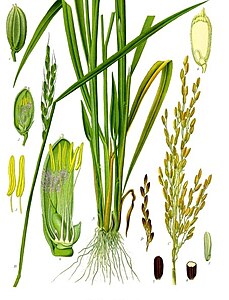
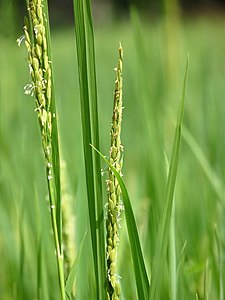

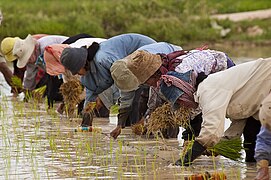


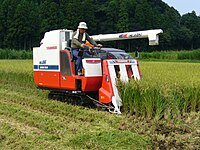
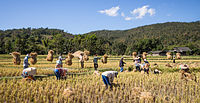

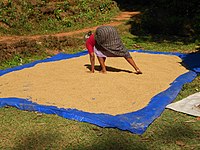
![Production of rice (2021)[23]](http://upload.wikimedia.org/wikipedia/commons/thumb/8/82/Production_of_rice_%282019%29.svg/400px-Production_of_rice_%282019%29.svg.png)


